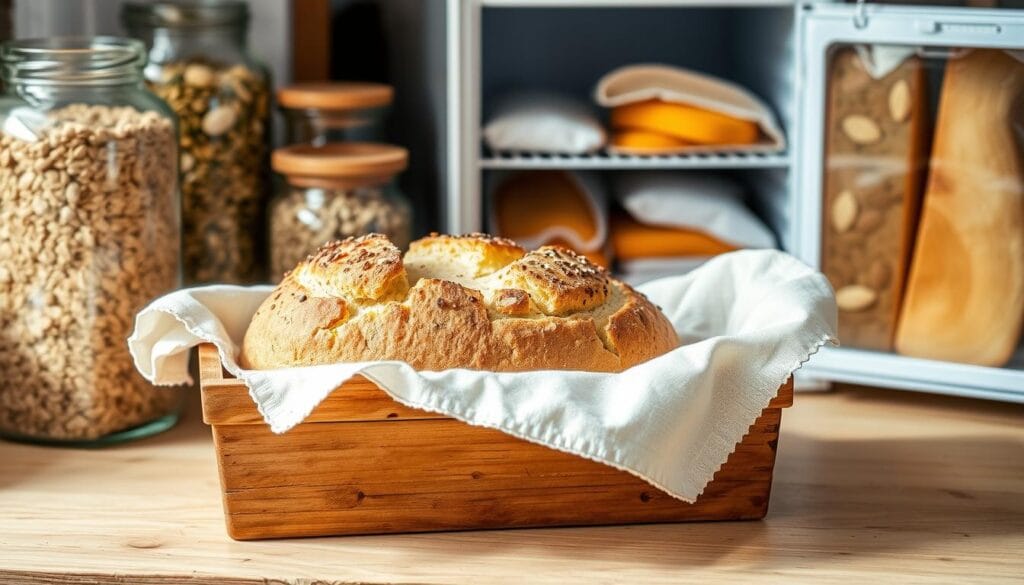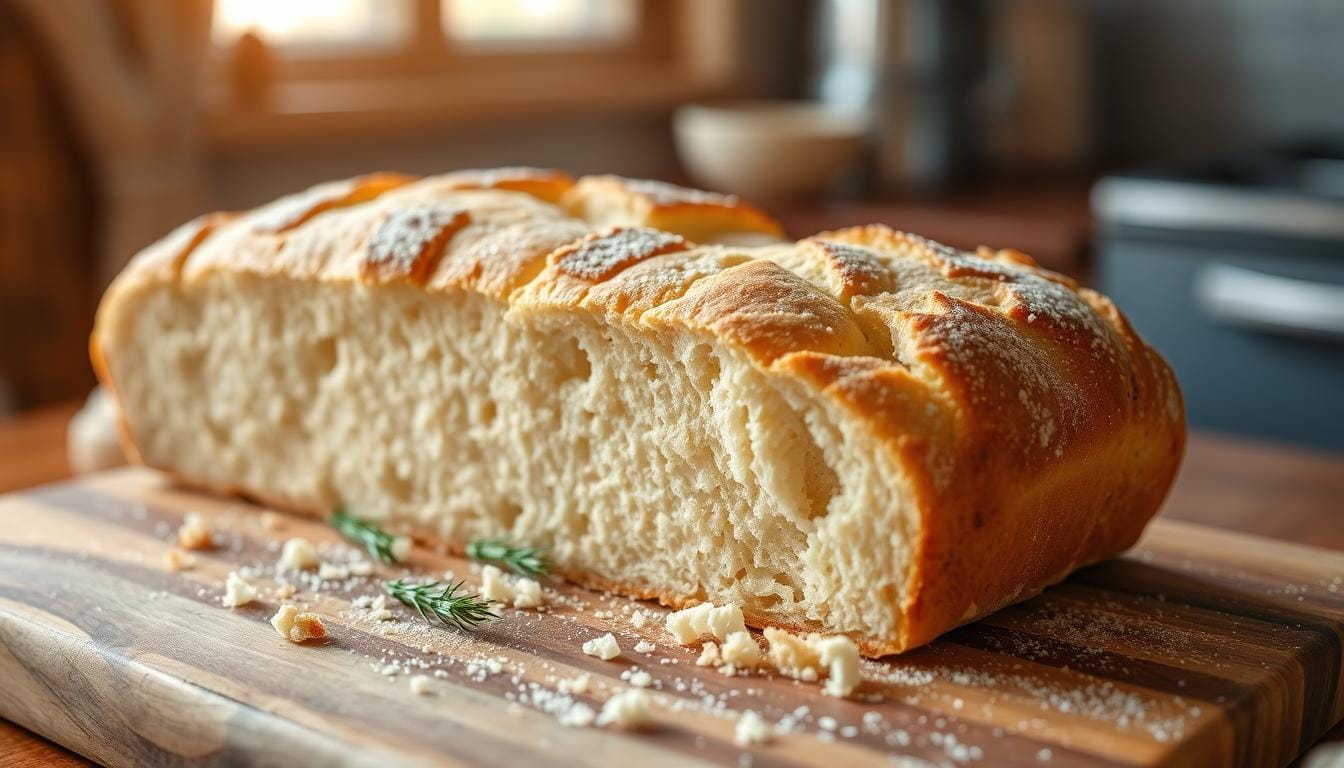Homemade Cottage Cheese Bread: Soft & Delicious
As a busy mom of three, I’m always searching for healthy, tasty recipes. Homemade cottage cheese bread is a game-changer for our family. It’s a simple, two-ingredient recipe that’s packed with protein.
With just cottage cheese and self-rising flour, you can make a soft, fluffy loaf. The cottage cheese adds a cheesy richness, while the flour makes it biscuit-like. Plus, each slice has about 9 grams of protein, perfect for boosting your protein intake.
Table of Contents
Why This High-Protein Bread Will Become Your New Favorite
Cottage cheese bread is a game-changer for those looking for a healthy and tasty bread option. It has about 11 grams of protein per slice, making it a great choice for a protein-rich diet. The cottage cheese adds a creamy texture and boosts the bread’s nutritional value.
Benefits of Cottage Cheese in Bread Making
Cottage cheese is a versatile ingredient that makes bread better. It adds moisture and a soft, tender crumb. This makes the bread enjoyable to eat. Plus, the protein in cottage cheese makes the loaf more substantial, perfect for sandwiches or toast.
Nutritional Profile and Health Benefits
Cottage cheese bread is good for your health. It has fewer calories than mozzarella or cheddar cheese. The mix of cottage cheese and oats gives you protein and complex carbs for steady energy.
Perfect for Protein-Rich Diet
For those on a protein-rich diet, cottage cheese bread is a must-try. Each slice has about 11 grams of protein. This supports muscle growth, weight management, and overall health, making it a nutritious choice.
| Ingredient | Protein Content |
|---|---|
| Cottage Cheese (100g) | 11g |
| Egg (1 large) | 13g |
| Cottage Cheese Bread (1 slice) | ~11g |
Essential Ingredients for Cottage Cheese Bread
Making the perfect cottage cheese bread begins with choosing the right ingredients. Cottage cheese is the main ingredient. You can use full-fat or low-fat cottage cheese, like Good Culture. It adds creaminess and protein to the bread.
You’ll also need self-rising flour or a mix of all-purpose flour, baking powder, and salt. Eggs help bind the ingredients together. Olive oil adds moisture and flavor. Rolled oats can add texture and nutrition.
- Cottage cheese (full-fat or low-fat)
- Self-rising flour (or all-purpose flour with baking powder and salt)
- Eggs
- Olive oil
- Rolled oats (optional)
- Shredded cheddar cheese, herbs, or spices (optional add-ins)
The cottage cheese flatbread recipe has become popular on TikTok. It’s a healthier alternative to regular bread. It’s gluten-free, high in protein, and low in calories. It only needs two ingredients: cottage cheese and eggs. Using full-fat cottage cheese makes it taste richer.
| Ingredient | Quantity |
|---|---|
| Cottage Cheese | 300g |
| Rolled Oats | 200g |
| Eggs | 2 |
| Flax Seeds | 2 tablespoons |
| Pumpkin Seeds | 25g |
| Sunflower Seeds | 25g |
With these ingredients, you can make a tasty and healthy cottage cheese bread. It will soon become a favorite in your household.
Kitchen Tools and Equipment Needed
To make this tasty homemade cottage cheese bread, you’ll need some basic tools. First, grab a large mixing bowl, a wooden spoon, and a baking sheet covered with parchment paper. A 9×5-inch bread pan is key for shaping and baking the loaf.
Must-Have Baking Tools
- Large mixing bowl
- Wooden spoon
- Baking sheet
- Parchment paper
- 9×5-inch bread pan
Optional Equipment for Better Results
While not essential, some extra tools can help a lot. A food processor makes mixing ingredients and dough smooth. A stand mixer with a dough hook attachment eases kneading. A sharp serrated knife is great for slicing the cooled bread. Lastly, a cooling rack helps the loaf cool down before serving.
- Food processor
- Stand mixer with dough hook
- Serrated knife
- Cooling rack
The main baking equipment and kitchen tools for bread making are crucial. They help get the perfect texture and rise in your homemade cottage cheese bread.
Step-by-Step Mixing Instructions
Making homemade cottage cheese bread is easy and fun. Start by heating your oven to 400°F (200°C). In a big bowl, mix together 4 2/3 cups (582 g) of bread flour, 1 tablespoon (10 g) of Diamond Crystal kosher salt, and 1 1/2 teaspoons (5 g) of active dry yeast. Whisk these dry ingredients until they’re well mixed.
Then, add 1 cup (255 g) of cottage cheese and 1 cup (250 g) of egg whites to the dry mix. Use a wooden spoon or your hands to mix until a dough starts to form. If the dough feels too dry, add 1/3 cup (75 g) of lukewarm water slowly. Keep kneading until it’s smooth and easy to shape.
- Knead the dough for 5 to 6 minutes to develop the gluten.
- Shape the dough into a ball or log and put it in a greased baking pan.
- Cover the dough and let it proof for 1 hour, until it doubles in size.
- If you want, sprinkle shredded cheese on top before baking for more flavor.
Your cottage cheese bread dough is now ready for the oven. Bake at 400°F (200°C) for 40 to 45 minutes. The crust should be golden, and a toothpick inserted into the center should come out clean. Let the bread cool for at least 10 minutes before slicing. Enjoy this protein-rich treat!

“The combination of cottage cheese and bread flour results in a soft, tender crumb that is both satisfying and nutritious.”
Tips for Perfect Dough Consistency
Getting the right dough consistency is key for a soft, tasty cottage cheese bread. You want a dough that’s slightly sticky but still easy to work with. Here are some tips and techniques to help you get the dough just right.
Proper Kneading Techniques
Kneading the dough is crucial for its texture and structure. Use your hands or a stand mixer with a dough hook. Knead until the dough comes together in a ball. Don’t overdo it, as this can make the bread tough.
If the dough is too sticky, lightly flour your hands or the surface. This helps prevent it from sticking.
Understanding Dough Texture
The perfect cottage cheese bread dough is soft and slightly tacky. It should hold its shape but still be pliable. If it’s too dry, add a tablespoon of water and knead it in.
If it’s too sticky, add a bit more flour until it’s just right.
“The key to perfect cottage cheese bread dough is finding the sweet spot between too dry and too sticky. With a little practice, you’ll be able to nail that perfect, pillowy texture every time.”
| Dough Consistency | Characteristics | Troubleshooting |
|---|---|---|
| Ideal | Soft, slightly tacky, holds its shape | – |
| Too Dry | Stiff, crumbly, difficult to work with | Add 1 tbsp of water and knead until desired consistency |
| Too Sticky | Extremely wet, difficult to handle | Gradually incorporate more flour until dough is manageable |
Baking Temperature and Timing Guide
Baking the perfect cottage cheese bread needs careful attention to temperature and timing. To get a soft and delicious texture, follow these guidelines closely.
Preheat your oven to 350°F (175°C) for baking the cottage cheese flatbread. Bake the flatbread for 35 to 40 minutes, or until it turns golden brown. Watch the bread closely to avoid it becoming dry or crispy.
If you’re baking a cottage cheese bread loaf, it will take about 60 minutes. The bread is done when it’s golden brown and firm in the center. To check if it’s done, insert a toothpick into the center. If it comes out clean, the bread is ready.
Whether you’re making a flatbread or a loaf, let the bread cool completely on a cooling rack before slicing. This helps the texture and prevents the bread from falling apart.
Baking time can vary based on your oven and the bread’s thickness. Be ready to adjust the time as needed for the perfect baking cottage cheese bread.
| Bread Type | Baking Temperature | Baking Time |
|---|---|---|
| Cottage Cheese Flatbread | 350°F (175°C) | 35-40 minutes |
| Cottage Cheese Bread Loaf | 350°F (175°C) | 60 minutes |
The bread baking temperature is key for the perfect texture and doneness. Adjust the timing as needed to ensure your cottage cheese bread is soft, delicious, and fully baked.
Creative Variations of Cottage Cheese Bread
Cottage cheese bread is a canvas for creativity. You can make it sweet or savory. Just add different ingredients to the mix.
Sweet and Savory Options
For something sweet, try vanilla extract, honey, or chocolate chips. These add a nice sweetness. For savory, add garlic powder, Italian seasoning, or fresh herbs like rosemary or thyme. These make the bread great with soups or spreads.
Adding Extra Ingredients
Be creative with cottage cheese bread. Use it for pizza crusts, dinner rolls, or mix in Greek yogurt or ricotta. These changes can bring new flavors and textures.
Remember, cottage cheese bread can be anything you want. Try new flavors and enjoy the endless possibilities.
“Cottage cheese bread is the ultimate canvas for culinary creativity. From sweet to savory, the options are endless!”
Storage and Freezing Methods
After baking your homemade cottage cheese bread, it’s key to store it right. This keeps it fresh and soft. Here are some tips to help:
To keep your bread fresh at room temperature, cool it down first. Then, place it in an airtight container. It will stay fresh overnight. For longer, refrigerate it for up to 7 days.
Freezing is great for longer storage. Slice the bread before freezing. Put the slices in a freezer-safe bag or container. Your bread will last up to 3 months in the freezer.
To thaw frozen bread, let it sit in the fridge overnight. To reheat, microwave the slices for 20 seconds at a time. Make sure it cools down completely before storing to avoid moisture.

With these easy storage and freezing tips, you can enjoy your homemade cottage cheese bread anytime you want!
Serving Suggestions and Pairing Ideas
Discover the best ways to enjoy your homemade cottage cheese bread. It’s perfect for breakfast, lunch, or a snack. This bread can make any meal more delicious.
Breakfast Combinations
Begin your day with toasted cottage cheese bread. Spread cream cheese on it and add honey for a sweet treat. Or, try it with a fried egg, avocado, and sea salt for a savory option.
Sandwich Recommendations
The cottage cheese bread is great for sandwiches. It adds protein and texture. Top it with turkey, cheese, and your favorite spreads for a protein-packed lunch. Or, layer it with roasted veggies, hummus, and balsamic glaze for a veggie delight.
| Topping Idea | Nutritional Benefits |
|---|---|
| Almond Butter and Sliced Bananas | Provides healthy fats, protein, and natural sweetness. |
| Smoked Salmon and Capers | Offers omega-3 fatty acids, protein, and a savory flavor profile. |
| Peanut Butter and Strawberry Jam | Combines protein, natural sugars, and a classic flavor combination. |
| Mashed Avocado and Tomato Slices | Delivers heart-healthy fats, vitamins, and a fresh, vibrant taste. |
The cottage cheese bread’s neutral taste lets you try many toppings. It’s perfect for making meals versatile and tasty all day long.
Troubleshooting Common Baking Issues
Baking homemade cottage cheese bread can be rewarding, but you might face some challenges. With a bit of troubleshooting, you can solve these problems and get a perfect loaf every time.
If your bread is too dense, don’t overmix the dough. This can make it heavy. For a crispier crust, brush the top with olive oil before baking. If it’s too moist, strain the cottage cheese well before adding it to the dough.
To fix an undercooked center, adjust the baking time. Use a meat thermometer to check the temperature. Keep baking in small increments until it hits 205°F (96°C). Always use room temperature ingredients and measure them accurately for consistent results.
If your bread doesn’t rise, check your yeast or baking powder. Make sure they’re fresh. Proper kneading and letting the dough proof for the right time are also key for a good rise.
By tackling these common issues, you’ll soon enjoy your homemade cottage cheese bread. With practice and attention to detail, you’ll become a bread-making expert.
| Baking Issue | Possible Cause | Solution |
|---|---|---|
| Bread is too dense | Overmixing the dough | Avoid overworking the gluten |
| Crust is not crispy | Lack of browning | Brush the top with olive oil before baking |
| Bread is too moist | Insufficient straining of cottage cheese | Strain the cottage cheese thoroughly before use |
| Bread is undercooked in the center | Insufficient baking time | Use a meat thermometer to check internal temperature and adjust baking time |
| Bread doesn’t rise properly | Expired yeast or baking powder | Check the freshness of your leavening agents and replace if needed |
By addressing these common bread baking problems, you’ll be well on your way to fixing any issues and enjoying the soft, protein-rich texture of your homemade cottage cheese bread. With a little practice and attention to detail, you’ll become a true bread-making pro in no time.
Why Choose Homemade Over Store-Bought
Choosing homemade bread over store-bought can greatly impact nutrition, taste, and quality. Homemade cottage cheese bread often has more protein than many store-bought options. Making it at home lets you pick the ingredients and flavors you like.
Homemade bread avoids preservatives and additives found in store-bought bread. This makes it taste fresher and better. Baking bread at home is rewarding and can save money. It lets you control what’s in your food and feel accomplished.
By making your own cottage cheese bread, you’re improving your health. Homemade bread is nutritious, tasty, and free from preservatives. It’s a healthier choice than store-bought bread, especially if you want to eat less saturated fat or more protein.
FAQ
What is the key ingredient in cottage cheese bread?
How much protein is in each slice of cottage cheese bread?
What other ingredients are used in cottage cheese bread?
What kitchen tools are needed to make cottage cheese bread?
How do you mix and knead the cottage cheese bread dough?
What is the optimal dough consistency for cottage cheese bread?
How long should cottage cheese bread be baked?
Can I customize the flavor of cottage cheese bread?
How should cottage cheese bread be stored?
What are some serving suggestions for cottage cheese bread?
What are some common issues that can arise when baking cottage cheese bread?
Source Links
- Cheesy Cottage Cheese Bread (2-Ingredient!) – https://thebalancednutritionist.com/cottage-cheese-bread-2-ingredient/
- Cottage Cheese Bread – https://healthyfitnessmeals.com/cottage-cheese-bread/
- Easy Best Low Carb Keto Cottage Cheese Bread Recipe – https://www.sugarfreemom.com/recipes/easy-best-low-carb-keto-cottage-cheese-bread-recipe/
- Why cottage cheese bread is the viral recipe of the moment – https://www.getthegloss.com/health/cottage-cheese-bread
- Quick Cottage Cheese Flatbread Is the Perfect Protein-Rich Bread Swap – https://www.firstforwomen.com/food-recipes/food-healthy/quick-flatbread-recipe
- Cottage Cheese Oat Bread Recipe [High Protein, Gluten Free] – https://alphes-corner.com/2024/06/06/cottage-cheese-oat-bread-recipe-high-protein-gluten-free/
- Cottage Cheese Bread – https://lifecurrentsblog.com/cottage-cheese-bread/
- 2 Ingredient Cottage Cheese Flatbread {41g Protein} – https://mattsfitchef.com/cottage-cheese-flatbread/
- Gluten-Free Cottage Cheese Bread – Gluten-Free Palate – https://www.glutenfreepalate.com/gluten-free-cottage-cheese-bread/
- 3 Ingredient Avocado Cottage Cheese Bread (Keto, Low Carb) – https://kirbiecravings.com/3-ingredient-avocado-cottage-cheese-bread/
- Cottage Cheese Flatbread (18 Grams of Protein) – iFoodReal.com – https://ifoodreal.com/cottage-cheese-flatbread/
- Cottage Cheese Bread — The Happy Place – https://www.thehappyplacepresents.com/blog/cottage-cheese-bread
- Cottage Cheese Bread – iFoodReal.com – https://ifoodreal.com/cottage-cheese-bread/
- 2 Ingredient Cottage Cheese Flat Bread Recipe – Yummy Whole Food Recipes – https://yummywholefoodrecipes.com/2-ingredient-high-protein-cottage-cheese-flatbread-recipe/
- Cottage Cheese Flatbread – https://themodernnonna.com/cottage-cheese-flatbread/
- Viral Cottage Cheese Flatbread (Easy Protein Recipe) – https://basicswithbails.com/course/lunch/cottage-cheese-flatbread/
- Cottage Cheese Flatbread – hellofrozenbananas.com – https://hellofrozenbananas.com/cottage-cheese-flatbread/
- Flourless Cottage Cheese Bread {10g protein} – The Big Man’s World ® – https://thebigmansworld.com/cottage-cheese-bread/
- Viral Cottage Cheese Toast (Easy Sweet & Savory Ideas) – https://grilledcheesesocial.com/2024/07/08/easy-cottage-cheese-toast-ideas/
- Easiest Cottage Cheese Bread with Almond Flour Keto Recipe – https://coachrallyrus.com/keto-recipes/keto-cottage-cheese-bread-almond-flour/
- Cottage Cheese Bread Recipe: Fluffy, Nutritious, and Easy – https://www.deliciouscheeserecipes.com/cottage-cheese-bread-recipe/
- Cottage Cheese Banana Bread – https://reallifenutritionist.com/cottage-cheese-banana-bread/
- Cottage Cheese Wrap – https://www.eatingbirdfood.com/cottage-cheese-wrap/
- Quick 5-minute Cottage Cheese Breakfast Toast – https://cleananddelicious.com/quick-5-minute-cottage-cheese-breakfast-toast/
- Cottage Cheese Toast (4 Ways!) – https://happyhealthymama.com/cottage-cheese-toast-4-ways.html
- Cottage Cheese Flatbread: Perfect Texture Guide [2024 Tips] – https://inminutesrecipes.com/cottage-cheese-flatbread-why-texture-matters/
- Easy Best Low Carb Keto Cottage Cheese Bread Recipe – https://inminutesmeals.com/cottage-cheese-bread/
- Cottage Cheese Bread Boasts 50% More Protein Than a Regular Loaf and Is Easy To Make: 2 Recipes – https://www.yahoo.com/lifestyle/cottage-cheese-bread-50-more-182833231.html
- Cottage Cheese Bread – https://frontyardveggies.com/cottage-cheese-bread-bread-machine-recipe/

